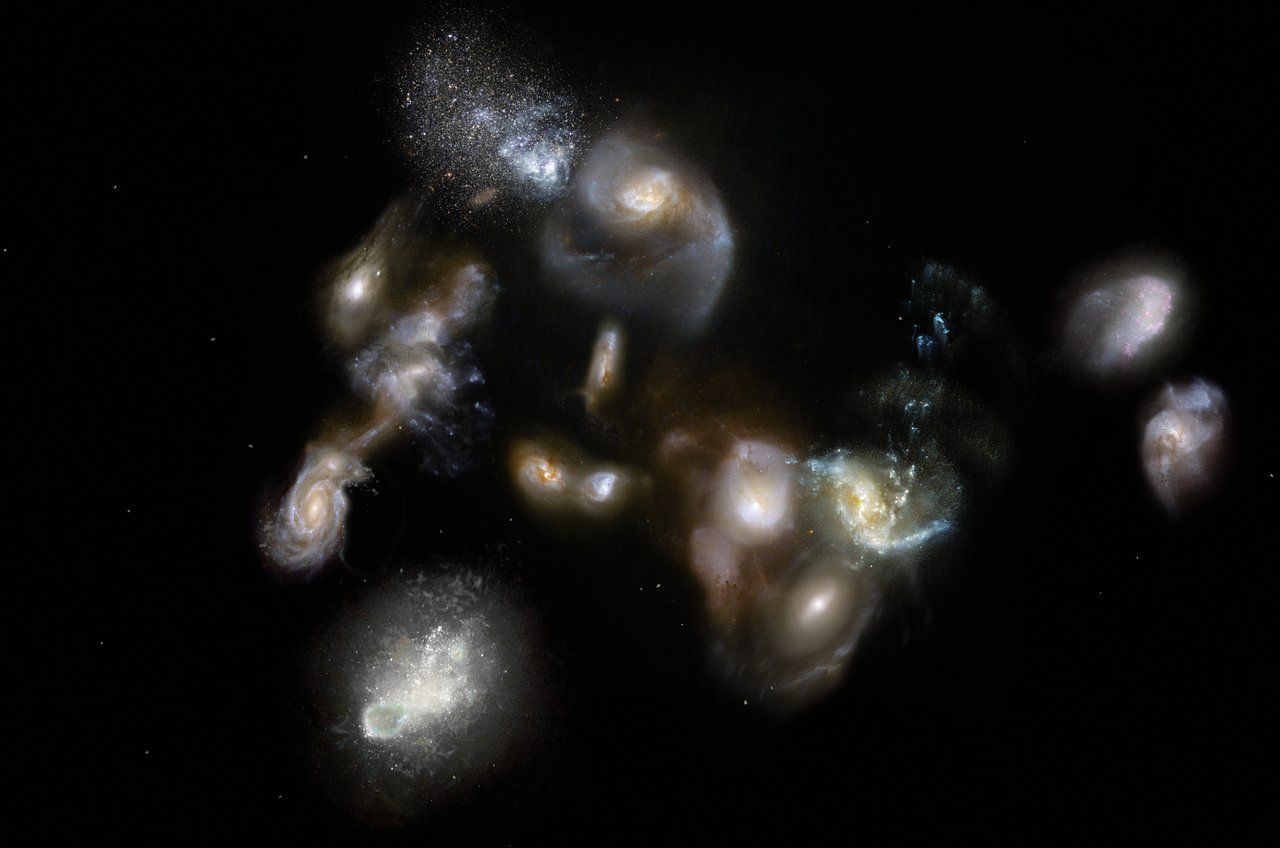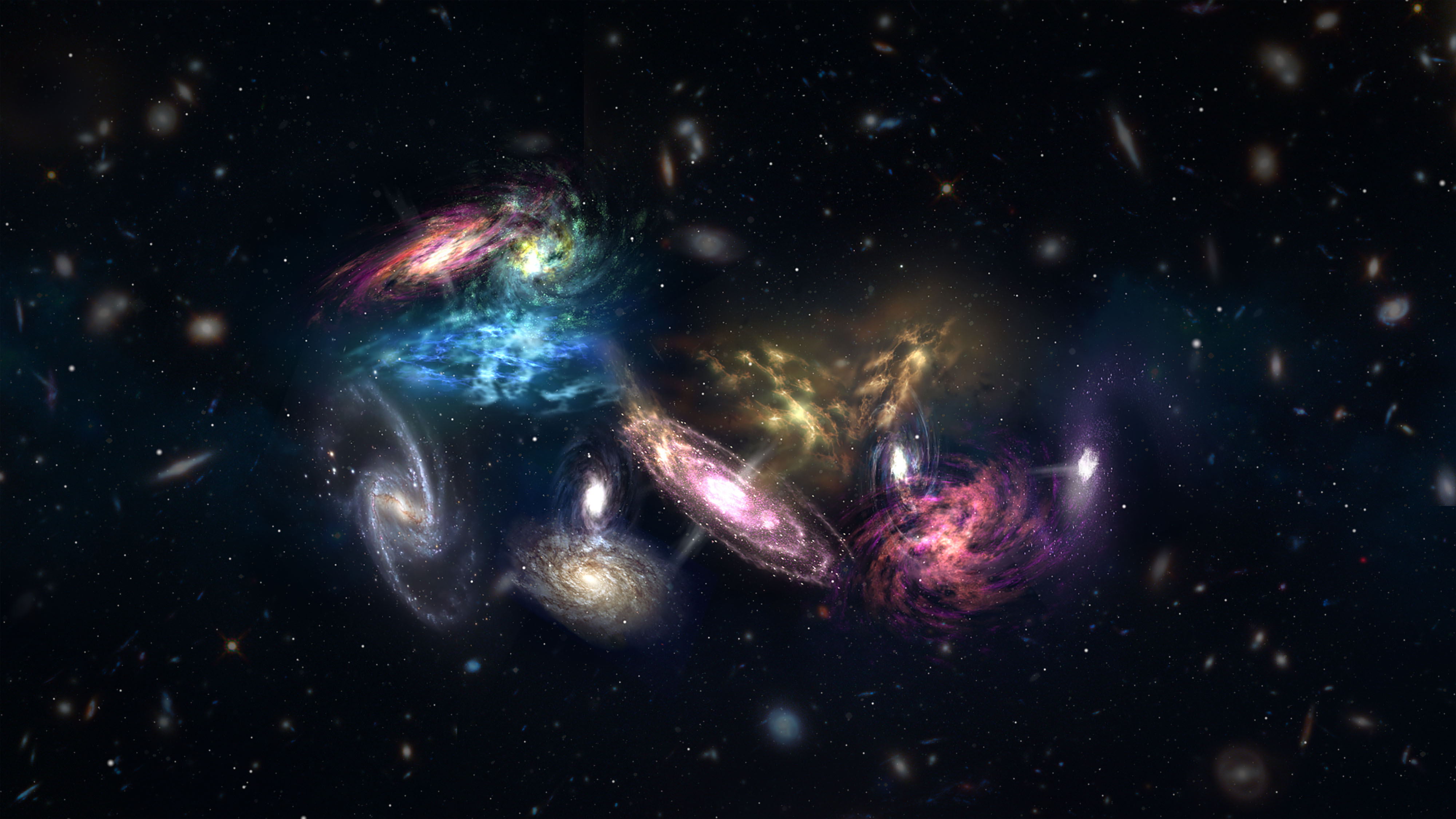Scientists Peer Across the Universe and Find an Ancient Galactic Collision
Astronomers set their sights on an area incredibly far away — more than 90 percent of the way across the observable universe — and found the beginnings of a massive cosmic collision, according to two new studies.
The crash they witnessed is an early formation stage for the largest type of structure in the known universe, and the recent findings suggest that the process took significantly less time than computer models have suggested. In addition, the abundance of dusty star-forming areas in this collision raises questions about how galaxies evolve.
Both research studies focused on a galactic collision that scientists believe has already happened. Fourteen galaxies, collectively known as SPT2349-56, are bursting with newly created stars, according to a recent statement by the European Southern Observatory (ESO). The reason ESO defines it as an impending crash is because, from Earth, we cannot yet see what's presently happening at the merger site. That's because light takes a very long time to travel to us from that region in space. [Galactic 'Mega City' Shows Mysterious Spots of Star Formation (Images)]

According to Iván Oteo, a postdoctoral researcher at the University of Edinburgh and lead author of one of the studies, his team's work reveals unexpected findings about the star-bursting regions. "The lifetime of dusty starbursts is thought to be relatively short, because they consume their gas at an extraordinary rate," he said in the statement. "At any time, in any corner of the Universe, these galaxies are usually in the minority. So, finding numerous dusty starbursts shining at the same time like this is very puzzling, and something that we still need to understand."
Scott Chapman, an astrophysicist at Dalhousie University in Halifax, Nova Scotia, who worked on the second study, also commented on his team's finding that the formation stage took less time than expected. "Having caught a massive galaxy cluster in [the] throes of formation is spectacular in and of itself," he said. "But the fact that this is happening so early in the history of the universe poses a formidable challenge to our present-day understanding of the way structures form in the universe."

The international teams of scientists used ESO's Atacama Large Millimeter/submillimeter Array (ALMA) and Atacama Pathfinder Experiment (APEX) telescopes to peer back in time to when the universe was one-tenth of its present age. SPT2349-56 is located about 12.4 billion light-years away, and this means the light from this structure started traveling toward Earth when the universe was about 1.4 billion years old. (The universe is approximately 13.8 billion years old.)
SPT2349-56 is a so-called protocluster, thought to be the building-block stage for the largest known structure to exist, a galaxy cluster.
Get the Space.com Newsletter
Breaking space news, the latest updates on rocket launches, skywatching events and more!
The individual galaxies in galaxy clusters are held together by dark matter, according to the National Radio Astronomy Observatory. During the universe's first few million years, dark matter (and normal matter) began to collect into larger concentrations, eventually creating galaxy clusters. Some clusters are thought to contain up to thousands of galaxies.
To study the formation stage the protocluster was exhibiting, researchers ran observational data from the ALMA telescope through computer simulations. The two teams found that what they were witnessing occurred less than 1.4 billion years after the Big Bang. However, existing theoretical and computer models suggest that a protocluster as large as SPT2349-56 should have taken much longer to evolve.
"How this assembly of galaxies got so big, so fast is a mystery," Tim Miller, a doctoral candidate at Yale University and lead author of one of the papers, said in the statement. "It wasn't built up gradually over billions of years, as astronomers might expect. This discovery provides a great opportunity to study how massive galaxies came together to build enormous galaxy clusters."
The research was presented today (April 25) in two papers. The work of Miller's team appears in the journal Nature, and the work of the team led by Oteo appears in The Astrophysical Journal.
Follow Doris Elin Salazar on Twitter @salazar_elin. Follow us @Spacedotcom, Facebook and Google+. Original article on Space.com.
Join our Space Forums to keep talking space on the latest missions, night sky and more! And if you have a news tip, correction or comment, let us know at: community@space.com.

Doris is a science journalist and Space.com contributor. She received a B.A. in Sociology and Communications at Fordham University in New York City. Her first work was published in collaboration with London Mining Network, where her love of science writing was born. Her passion for astronomy started as a kid when she helped her sister build a model solar system in the Bronx. She got her first shot at astronomy writing as a Space.com editorial intern and continues to write about all things cosmic for the website. Doris has also written about microscopic plant life for Scientific American’s website and about whale calls for their print magazine. She has also written about ancient humans for Inverse, with stories ranging from how to recreate Pompeii’s cuisine to how to map the Polynesian expansion through genomics. She currently shares her home with two rabbits. Follow her on twitter at @salazar_elin.









